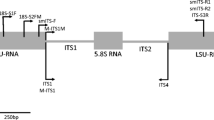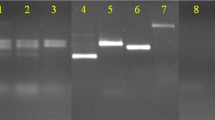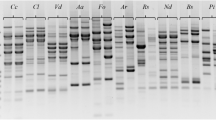Abstract
The ITS region of ectomycorrhizal fungi was analyzed, and species-specific PCR primers were designed for 8 ectomycorrhizal Tricholoma species. Although a high degree of intraspecific homology was observed, interspecific variation was sufficient to design species-specific primers based on sequence of the ITS region. PCR amplification with the specific primers generated fragments of the expected sizes from DNA extracted from the strains of each species but gave no amplified products from the strains of the other 16 species in eight genera. These results suggest that sequence of the ITS region is appropriate to be used for species-level identification of ectomycorrhizal fungi.
Similar content being viewed by others
References
R Agerer (1987–2006) Colour Atlas of Ectomycorrhizae, 1st–13th edn Einhorn-Verlag Schwäbisch Gmünd
R Agerer (1996–2006) Descriptions of Ectomycorrhizae, 1st–10th edn Einhorn-Verlag Schwäbisch Gmünd
A Amicucci A Zambonelli G Giomaro L Potenza V Stocchi (1998) ArticleTitleIdentification of ectomycorrhizal fungi of the genus Tuber by species-specific ITS primers Mol Ecol 7 273–277 Occurrence Handle10.1046/j.1365-294X.1998.00357.x Occurrence Handle1:CAS:528:DyaK1cXivVWqsb8%3D
SD Atkins IM Clark S Pande PR Hirsch BR Kerry (2005) ArticleTitleThe use of real-time PCR and species-specific primers for the identification and monitoring of Paecilomyces lilacinus FEMS Microbiol Ecol 51 257–264 Occurrence Handle16329874 Occurrence Handle10.1016/j.femsec.2004.09.002 Occurrence Handle1:CAS:528:DC%2BD2cXhtFGhtrrI
B Bago Y Piché L Simon (1998) ArticleTitleFluorescently-primed in situ PCR in arbuscular mycorrhizas Mycol Res 102 1540–1544 Occurrence Handle10.1017/S0953756298007011 Occurrence Handle1:CAS:528:DyaK1MXhtV2gtL0%3D
T Bertini D Agostini L Potenza I Rossi S Zeppa A Zambonelli V Stocchi (1998) ArticleTitleMolecular markers for the identification of the ectomycorrhizal fungus Tuber borchii New Phytol 139 565–570 Occurrence Handle10.1046/j.1469-8137.1998.00203.x Occurrence Handle1:CAS:528:DyaK1cXlsleqtrw%3D
L Bindslev RP Oliver B Johansen (2002) ArticleTitleIn situ PCR for detection and identification of fungal species Mycol Res 106 277–279 Occurrence Handle10.1017/S0953756202005646 Occurrence Handle1:CAS:528:DC%2BD38XlvVKmsrY%3D
S Erland B Henrion F Martin LA Glover IJ Alexander (1994) ArticleTitleIdentification of the ectomycorrhizal basidiomycete Tylospora fibrillosa Dong by RFLP analysis of the PCR-amplified ITS and IGS region ribosomal DNA New Phytol 126 525–532 Occurrence Handle10.1111/j.1469-8137.1994.tb04251.x Occurrence Handle1:CAS:528:DyaK2MXhsV2ruw%3D%3D
M Gardes TD Bruns (1993) ArticleTitleITS primers with enhanced specificity for basidiomycetes: application to the identification of ectomycorrhizae and rusts Mol Ecol 2 113–118 Occurrence Handle8180733 Occurrence Handle1:CAS:528:DyaK3sXlslOmsro%3D
M Gardes TD Bruns (1996) ArticleTitleCommunity structure of ectomycorrhizal fungi in a Pinus muricata forest: above- and below-ground views Can J Bot 74 1572–1583
M Glen AH Smith SRH Langrell CL Mohammed (2007) ArticleTitleDevelopment of nested polymerase chain reaction detection of Mycosphaerella spp. and its application to the study of leaf disease in Eucalyptus plantations Phytopathology 97 132–144 Occurrence Handle10.1094/PHYTO-97-2-0132 Occurrence Handle1:CAS:528:DC%2BD2sXitVClt7k%3D
PH Goodwin T Hsiang BG Xue HW Liu (1995) ArticleTitleDifferentiation of Gaeumannomyces graminis from other turf-grass fungi by amplification with primers from ribosomal internal transcribed spacers Plant Pathol 44 384–391 Occurrence Handle10.1111/j.1365-3059.1995.tb02791.x Occurrence Handle1:CAS:528:DyaK2MXnvVaitb8%3D
A Guerin-Laguette N Matsushita F Lapeyrie K Shindo K Suzuki (2005) ArticleTitleSuccessful inoculation of mature pine with Tricholoma matsutake Mycorrhiza 15 301–305 Occurrence Handle15856336 Occurrence Handle10.1007/s00572-005-0355-4
O Kårén N Högberg A Dahlberg L Jonsson JE Nylund (1997) ArticleTitleInter- and intraspecific variation in the ITS region of rDNA of ectomycorrhizal fungi in Fennoscandia as detected by endonuclease analysis New Phytol 136 313–325 Occurrence Handle10.1046/j.1469-8137.1997.00742.x
K Kikuchi N Matsushita A Gurein-Laguette A Ohta K Suzuki (2000) ArticleTitleDetection of Tricholoma matsutake by specific ITS primers Mycol Res 104 1427–1430 Occurrence Handle10.1017/S0953756200002653 Occurrence Handle1:CAS:528:DC%2BD3MXps1Wqsg%3D%3D
R Landeweert C Veenman TW Kuyper H Fritze K Wernars E Smit (2003) ArticleTitleQuantification of ectomycorrhizal mycelium in soil by real-time PCR compared to conventional quantification techniques FEMS Microbiol Ecol 45 283–292 Occurrence Handle10.1016/S0168-6496(03)00163-6 Occurrence Handle1:CAS:528:DC%2BD3sXmt1GrtbY%3D
Y Matsuda N Hijii (1999) ArticleTitleEctomycorrhizal morphotypes of naturally grown Abies firma seedlings Mycoscience 40 217–226 Occurrence Handle10.1007/BF02463958
T Nakai T Ohno (1994) ArticleTitleStudies on nucleic acids of some basidiomycetes: (4) Discrimination of T. matsutake by easy DNA-Sequencing (in Japanese) Proc Annu Meet Mycol Soc Jpn 38 97
I Paran RW Michelmore (1993) ArticleTitleDevelopment of reliable PCR-based markers linked to downy mildew resistance genes in lettuce Theor Appl Genet 85 985–993 Occurrence Handle10.1007/BF00215038 Occurrence Handle1:CAS:528:DyaK3sXktVWru70%3D
SE Smith DJ Read (1997) Mycorrhizal symbiosis EditionNumber2nd edn Academic Press San Diego
Y Terashima Y Nakai (1996) ArticleTitleIdentification of the DNAs of the ectomycorrhizal fungus Tricholoma bakamatsutake using specific oligonucleotide probes and PCR primers Mycoscience 37 371–375 Occurrence Handle10.1007/BF02461311 Occurrence Handle1:CAS:528:DyaK2sXhtVSjtbg%3D
JD Thompson TD Gibson FP Plewniak F Jeanmougin DG Higgins (1997) ArticleTitleThe CLUSTAL X windows interface: flexible strategies for multiple sequence alignment aided by quality analysis tools Nucleic Acids Res 25 4876–4882 Occurrence Handle9396791 Occurrence Handle10.1093/nar/25.24.4876 Occurrence Handle1:CAS:528:DyaK1cXntFyntQ%3D%3D
TJ White T Bruns S Lee J Taylor (1990) Amplification and direct sequencing of fungal ribosomal RNA genes for phylogenetics MA Innis DH Gelfand JJ Sninsky TJ White (Eds) PCR protocols Academic Press London 315–322
A Yamada K Katsuya (1996) ArticleTitleMorphological classification of ectomycorrhizal Pinus densiflora Mycoscience 37 125–155 Occurrence Handle10.1007/BF02461339
Author information
Authors and Affiliations
Corresponding author
About this article
Cite this article
Kikuchi, K., Matsushita, N. & Suzuki, K. Discrimination of Tricholoma species by species-specific ITS primers. Mycoscience 48, 316–320 (2007). https://doi.org/10.1007/s10267-007-0368-2
Received:
Accepted:
Published:
Issue Date:
DOI: https://doi.org/10.1007/s10267-007-0368-2




